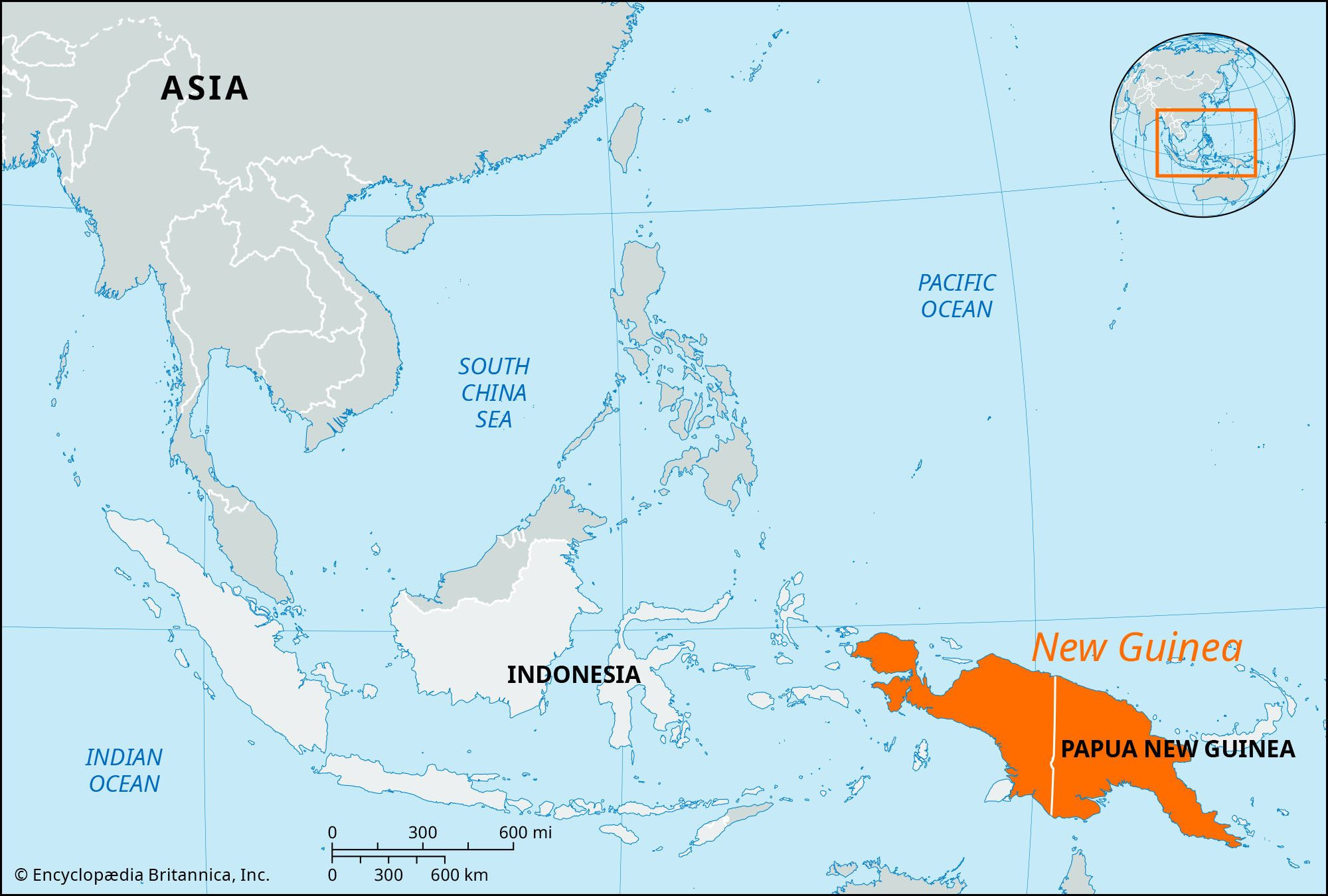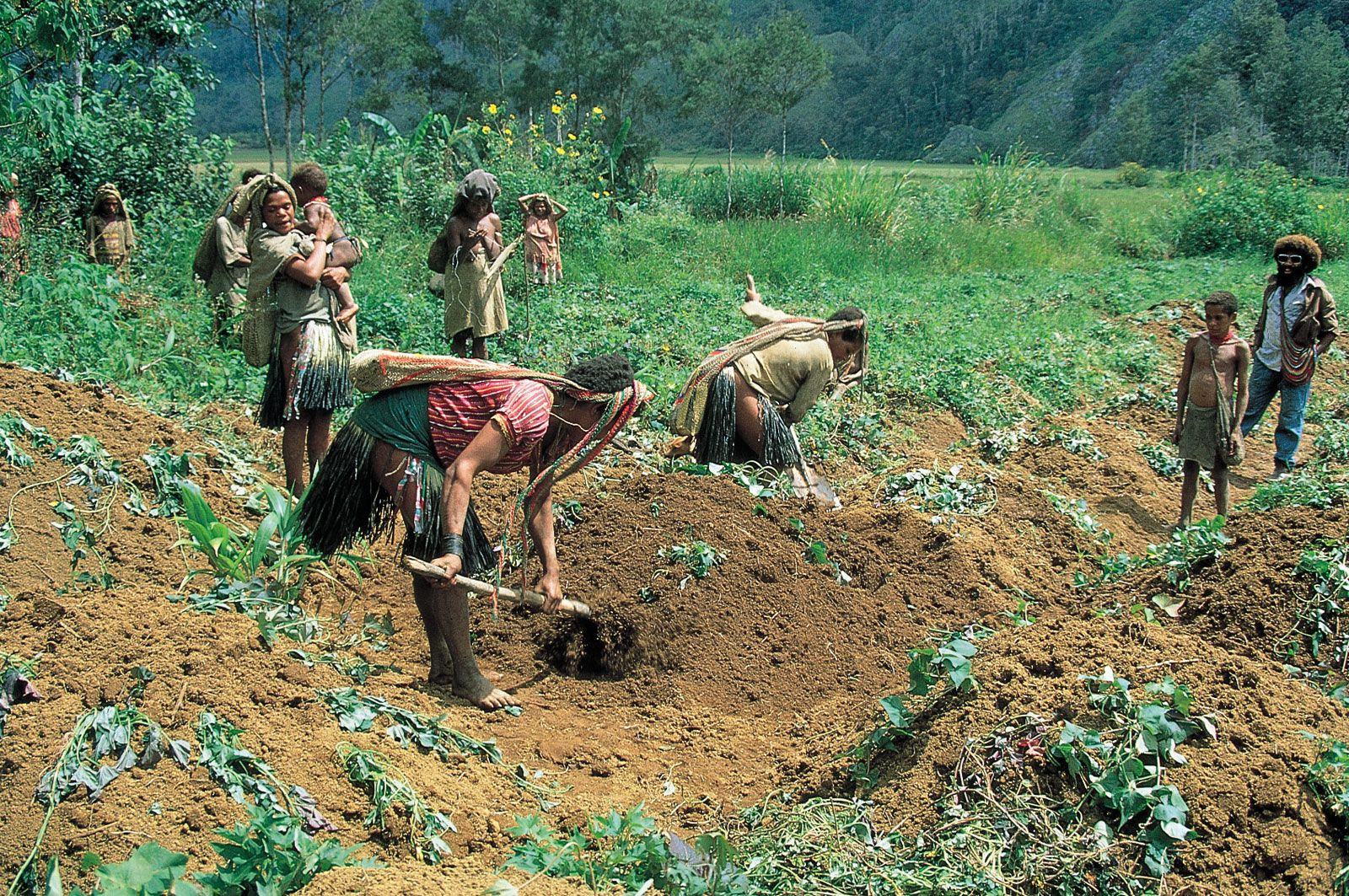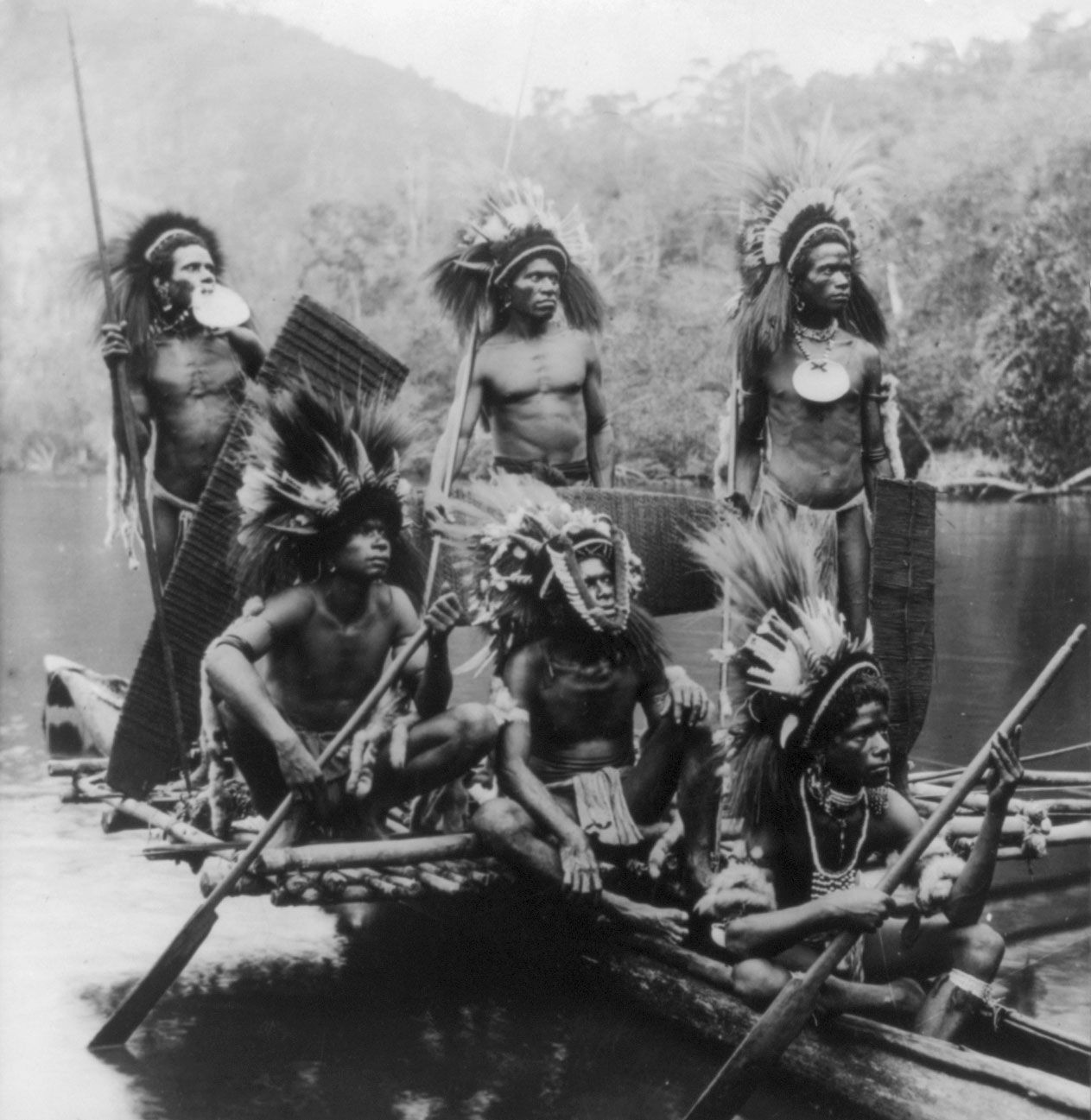New Guinea, a name that conjures images of lush rainforests, diverse cultures, and unexplored landscapes. But Where Is New Guinea exactly? Nestled in the vast expanse of the western Pacific Ocean, just north of Australia, New Guinea is more than just a point on the map. It’s a sprawling island, the second largest in the world after Greenland, and a land of incredible geographical and cultural richness. Understanding its location is the first step to appreciating the unique tapestry of this fascinating island.
To pinpoint where New Guinea is located, envision the eastern reaches of the Malay Archipelago. It sits comfortably north of the Australian continent, bordered by a network of seas that define its maritime environment. To its north lies the open expanse of the Pacific Ocean, while the Bismarck and Solomon Seas gently lap its eastern shores. The south is defined by the Coral Sea and the Torres Strait, separating it from Australia, and to the southwest, the Arafura Sea completes its watery embrace.
Administratively, New Guinea’s location places it across two distinct political entities. The western half of the island is integrated into Indonesia, forming the provinces of Papua and West Papua. Collectively, this region was once known as Irian Jaya. In contrast, the eastern half constitutes the major portion of Papua New Guinea, an independent nation that gained its sovereignty in 1975. This division adds a layer of political geography to the question of “where is New Guinea?”, highlighting its complex history and diverse influences.
Exploring the Land of New Guinea: A Geographical Overview
Beyond simply stating New Guinea’s location, understanding its land is crucial to grasping its character. Stretching approximately 1,500 miles from northwest to southeast and reaching a width of about 400 miles, New Guinea presents a significant landmass. Its area encompasses a massive 317,150 square miles (821,400 square km), making it a substantial presence in the global geography.
The spine of New Guinea is dominated by an imposing, unbroken chain of mountains that traverses the island from northwest to southeast. These mountains are not mere hills; they are giants, with peaks soaring above 13,000 feet (4,000 metres). The apex of this range is Jaya Peak, located in the western Papua province. Towering at 16,024 feet (4,884 metres), it stands as the highest point in Indonesia, a testament to New Guinea’s dramatic topography. These summits are often capped with glaciers, a surprising feature in a tropical locale, and the mountains cradle extinct volcanoes and fertile highland basins, often perched above 4,900 feet (1,490 metres).
North of this central mountain range lies a deep structural trench, carved out by the valleys of significant rivers. The Mamberamo, Sepik, Ramu, and Markham rivers snake through this region, shaping the landscape and ecosystems. Towards the north-central coast, a series of fault-rimmed mountains rise, though generally lower than the central range, typically below 11,500 feet (3,500 metres). In the extreme northwest, the Bomberai and Doberai Peninsulas jut out, offering a mix of lowlands and mountainous terrain, adding to the geographical diversity of New Guinea’s location.
South of the central mountains, the landscape transforms into the Fly-Digul shelf, a vast, swampy plain interlaced with a network of rivers. The Fly, Bian, Digul, Mapi, Pulau, and Lorentz rivers crisscross this area, creating a waterlogged environment that is both challenging and ecologically significant. Extending southeast, the Owen Stanley Range forms a wide peninsula, acting as a natural divider between the Solomon Sea to the north and the Coral Sea to the south. This range further emphasizes the varied geographical features within New Guinea’s location.
 Locator map of New Guinea in relation to Southeast Asia and Australia, highlighting its position in the Malay Archipelago and proximity to Australia.
Locator map of New Guinea in relation to Southeast Asia and Australia, highlighting its position in the Malay Archipelago and proximity to Australia.
The climate of New Guinea, due to its location, is predominantly tropical. Lowland areas experience consistently warm temperatures, with mean annual maximums ranging from 86 to 90 °F (30 to 32 °C). Even in the highlands, daytime temperatures generally remain above 72 °F (22 °C) throughout the year. Rainfall is abundant, particularly on the southern slopes of the central highlands, which are exposed to southeast trade winds for about seven months annually. These areas often receive over 300 inches (7,620 mm) of rain each year, making the Fly-Digul shelf and adjacent highlands among the wettest places on Earth, and consequently, sparsely populated. The central highlands still receive substantial rainfall, between 100 and 160 inches (2,540 and 4,065 mm) annually. In contrast, Port Moresby, located on the southeastern coast, is relatively drier, receiving around 40 inches (1,000 mm) of rain per year, showcasing the climatic variations within New Guinea’s geographical location.
The island’s rich plant life is a direct result of its tropical climate and diverse geography. Orchids, figs, and various species of false beech thrive here. Mangrove swamps fringe almost the entire coastline, transitioning inland to nipa palms. Sago palm stands are prevalent along the southern coast’s deltas and rivers. Primary lowland rainforest blankets much of New Guinea up to about 3,300 feet (1,000 metres) above sea level. Higher up, in the central highlands, oak, beech, and pine forests become common. Wildlife is equally diverse, including numerous reptiles, marsupials like tree kangaroos and phalangers, and notable bird species such as cassowaries, birds of paradise, and parrots, all contributing to the biodiversity of New Guinea’s unique location.
The People of New Guinea: Culture and Society
Understanding where New Guinea is also means understanding its people. The island is primarily inhabited by speakers of Papuan languages, the original settlers who predominantly reside in the interior and southern regions. Papuan societies are often characterized by leadership structures centered around local “big men” and the practice of reciprocal gift-giving, reflecting complex social and economic systems. The ethnic composition of Papuan groups is remarkably diverse, with approximately 700 distinct languages spoken across the island, highlighting the cultural richness within New Guinea’s location.
Coastal areas and offshore islands are home to smaller communities speaking Austronesian (Melanesian) languages, representing a later wave of migration and cultural influence. There are also minor populations of Polynesians, Chinese, and Europeans, reflecting more recent global interactions. Several pidgin languages, such as Tok Pisin and Hiri Motu, serve as lingua francas, facilitating communication across diverse linguistic groups. Indonesian and English, the official languages of Indonesia and Papua New Guinea respectively, are also spoken, reflecting the island’s colonial and post-colonial history, further contextualizing New Guinea’s location in a globalized world.
While Christianity is the dominant religion in Papua New Guinea, traditional religious beliefs and rituals remain widely practiced across the island, showcasing a blend of modernity and ancient traditions. The central highlands, the most densely populated part of New Guinea, have seen significant transformation of natural vegetation due to intensive agriculture practiced by highlanders. Swidden (slash-and-burn) cultivation is common in the forested foothills north of the highlands and in the grasslands of the Mamberamo and Sepik river basins, areas with sparser populations. The north coast is also relatively well-populated, indicating varied population densities across New Guinea’s geographical location.
Economy of New Guinea: Resources and Livelihoods
The economy of New Guinea is intrinsically linked to its geography and resources. New Guinea’s location is rich in mineral deposits, particularly copper and gold. One of the world’s largest copper concentrations is found at Tembagapura in Papua, near Jaya Peak. Another significant copper deposit, along with substantial gold reserves, is developed at Ok Tedi, within Papua New Guinea. Petroleum extraction occurs in the Doberai Peninsula of Papua and near Lake Kutubu in Papua New Guinea. Natural gas deposits have also been discovered in the Fly-Kikori area of Papua New Guinea, underscoring the economic potential embedded within New Guinea’s location.
However, the majority of New Guinea’s population are subsistence farmers. In the lowlands, staple foods include yams, taro, sago, and bananas. Sweet potatoes are the primary food source in the highlands. Pig husbandry is widespread throughout the island, playing a significant role in local economies and cultures. Cash crops in Papua New Guinea include coffee, cacao, copra, palm oil, tea, and rubber. Exports also include skyjack tuna, prawns, and timber. Internal transport relies on limited coastal roads, riverboats, and increasingly, airways, reflecting the challenges and opportunities presented by New Guinea’s location and terrain.
 Sweet potato farming in Papua New Guinea's Southern Highlands province, showcasing the agricultural practices and staple crops of the region.
Sweet potato farming in Papua New Guinea's Southern Highlands province, showcasing the agricultural practices and staple crops of the region.
A Glimpse into New Guinea’s History
New Guinea’s location has placed it at the crossroads of historical currents for millennia. The island’s history stretches back possibly 50,000 years, with evidence of early human occupation. By around 7000 BCE, sedentary agriculture, including sophisticated swamp drainage and irrigation systems, was practiced in the highland basins, indicating advanced societal development. The island, particularly its western part, was known to Indonesian and Asian seafarers long before European contact.
The Portuguese were the first Europeans to sight New Guinea in 1511, although they did not land until 1527. The Dutch claimed the western half in 1828 as part of the Dutch East Indies. In the 1870s, Captain John Moresby of Great Britain surveyed the southeastern coast, leading to Britain annexing the southeastern quadrant in 1884. The German New Guinea Company assumed administration of the northeastern quadrant in the same year, marking the onset of European colonial influence across New Guinea’s location.
British New Guinea’s administration was transferred to Australia in 1904 and renamed the Territory of Papua. Following World War I, German New Guinea became an Australian mandated territory under the League of Nations in 1921. During World War II, Japan occupied large parts of the island. After the war, Australia merged the administrations of Papua and the New Guinea mandate into the Territory of Papua and New Guinea. The western half, then known as Irian Barat, was returned to Dutch control post-war. Indonesia gained independence in 1949, and following a plebiscite in 1969, Irian Barat was annexed to Indonesia. Papua New Guinea achieved independence within the British Commonwealth in 1975, culminating a long and complex history shaped by its strategic location.
 Warriors in an outrigger canoe in New Guinea, circa 1919, depicting the historical seafaring traditions and indigenous culture of the island.
Warriors in an outrigger canoe in New Guinea, circa 1919, depicting the historical seafaring traditions and indigenous culture of the island.
In conclusion, where is New Guinea? It’s geographically located north of Australia, in the western Pacific Ocean, forming part of the Malay Archipelago. But beyond its coordinates, New Guinea is a world of its own. Its location dictates its tropical climate, its unique biodiversity, its diverse cultures, and its complex history. From its towering mountains to its vast rainforests, from its ancient traditions to its modern challenges, New Guinea stands as a testament to the power of location in shaping the identity and character of a place. Exploring New Guinea’s location is just the beginning of understanding this remarkable island and its significance in the world.

